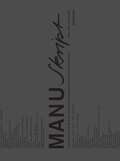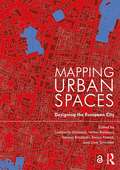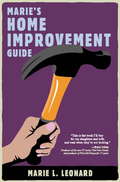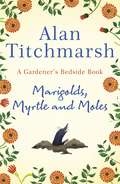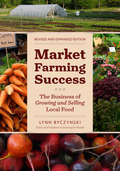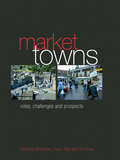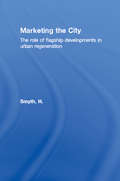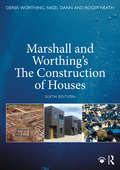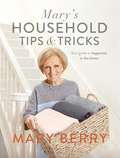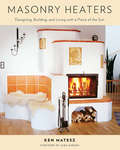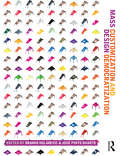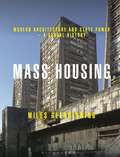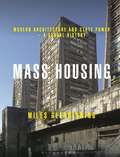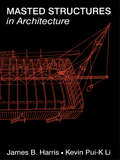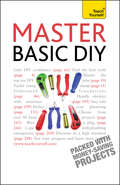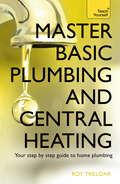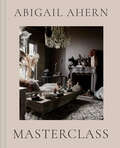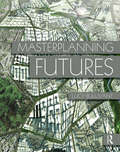- Table View
- List View
Manuskript: Essentials für den Alltag von Innenarchitekten und Designern
by Axel Müller-SchöllDas Buch bietet grundlegende erste Informationen für Innenarchitekten und Designer. Aus den Gebieten der Innenraumgestaltung zu Decken, Fußböden, Wänden, Türen, Fenstern, Treppen etc. Aus der Materialkunde: zu Teppichen, Tapeten, Wandanstrichen, Glas, Holzwerkstoffe, Stein, Beton. Ein weiterer Schwerpunkt ist dem Entwerfen und Aufzeichnen gewidmet: Darstellungstechniken, darstellende Geometrie, technische Zeichnungen, Orientierungsmaße, Zeichen und Symbole und mathematische Grundlagen; hinzu kommen grafische Grundbegriffe, Elemente der Druckvorstufe, Dateiformate und Farbsysteme. Ergänzt und veranschaulicht werden die Informationen mit Praxisbeispielen, originalen Textbeiträgen von Ruedi Baur, Axel Kufus, Norbert Rademacher, Martin Kunz u.a. sowie anregenden Zitaten. Falls der Leser, die Nutzerin des Buches wollen, können die Seiten in Japanbindung aufgetrennt werden: es entsteht so immer wieder Raum für persönlichen Ergänzungen und Notizen.
Mapping Urban Spaces: Designing the European City
by Lamberto Amistadi Valter Balducci Tomasz Bradecki Enrico Prandi Uwe SchröderMapping Urban Spaces focuses on medium-sized European cities and more specifically on their open spaces from psychological, sociological, and aesthetic points of view. The chapters illustrate how the characteristics that make life in medium-sized European cities pleasant and sustainable – accessibility, ease of travel, urban sustainability, social inclusiveness – can be traced back to the nature of that space. The chapters develop from a phenomenological study of space to contributions on places and landscapes in the city. Centralities and their meaning are studied, as well as the social space and its complexity. The contributions focus on history and theory as well as concrete research and mapping approaches and the resulting design applications. The case studies come from countries around Europe including Poland, Italy, Greece, Germany, and France, among others. The book will be of interest to students, scholars, and practitioners in architecture, urban planning, and landscape architecture.
Mapping Urban Spaces: Designing the European City
by Lamberto Amistadi Valter Balducci Tomasz Bradecki Enrico Prandi Uwe SchröderMapping Urban Spaces focuses on medium-sized European cities and more specifically on their open spaces from psychological, sociological, and aesthetic points of view. The chapters illustrate how the characteristics that make life in medium-sized European cities pleasant and sustainable – accessibility, ease of travel, urban sustainability, social inclusiveness – can be traced back to the nature of that space. The chapters develop from a phenomenological study of space to contributions on places and landscapes in the city. Centralities and their meaning are studied, as well as the social space and its complexity. The contributions focus on history and theory as well as concrete research and mapping approaches and the resulting design applications. The case studies come from countries around Europe including Poland, Italy, Greece, Germany, and France, among others. The book will be of interest to students, scholars, and practitioners in architecture, urban planning, and landscape architecture.
Marie's Home Improvement Guide
by Marie L. LeonardTired of paying the painter to create a mess on your floors? Can’t be held up another day waiting for a plumber between 9 and 5? Feeling threatened by the growing pile of fix-it projects in your basement? Marie’s Home Improvement Guide offers all the tips you need to tackle these projects ... yourself! Marie L. Leonard, owner of her own home improvement business, has been teaching home repair to women for years. With the belief that women shouldn’t have to depend on others for home repair, Leonard is helping thousands of women save money and time, conquering the fear of do-it-yourself work. Marie’s Home Improvement Guide provides readers with the know-how to tackle projects around the house. Leonard covers the basics: introduction to tools, safety precautions, necessary prep-work, and shopping for the right materials. Leonard’s tips are written in an informative and accessible manner, paired with detailed illustrations. A reassuring source of encouragement, Marie’s Home Improvement Guide is a must-have book for all first-time do-it-yourselfers.
Marigolds, Myrtle and Moles: A Gardener's Bedside Book
by Alan TitchmarshThe perfect bedside book for the green-fingered - hilarious and touching poems on a gardening theme written and introduced by the nation's favourite gardener and presenter of ITV's Love Your Garden, Channel 5's Secrets of the National Trust and with his own show on Classic FM.From touching poems on the peony, the snowdrop and the sweet pea to hilarious verse on Emily the Gardener and the Garden Design Course, this is Alan Titchmarsh's heartfelt and entertaining celebration of his favourite space - the garden.
Market Farming Success: The Business of Growing and Selling Local Food, 2nd Editon
by Lynn ByczynskiAn insider's guide to market gardening and farming for those in the business of growing and selling food, flowers, herbs, or plants. Market Farming Success identifies the key areas that usually trip up beginners—and shows how to avoid those obstacles. This book will help the aspiring or beginning farmer advance quickly and confidently through the inevitable learning curve of starting a new business. Written by the editor of Growing for Market, a respected trade journal for market farmers, Market Farming Success condenses decades of growing experience from every part of the United States and Canada. It focuses on the factors that are common to market gardeners everywhere and offers professional advice that includes: • How much you'll need to spend to start a market farming business; • How much you can expect to earn; • Which crops bring in the most money—and whether you should grow them; • The essential tools and equipment you will need; • The best places to sell your products; • How to keep records to maximize profits and minimize taxes; • Tricks of the trade that will make you more efficient in the greenhouse, field, and market. This new Chelsea Green edition of a 2006 classic is greatly updated and expanded, and includes full-color photos, charts, and graphs, plus many inspiring and instructive profiles of successful market-farming pioneers.
Market Towns: Roles, challenges and prospects
by Neil PoweOriginal and insightful, this volume, giving in-depth consideration to the key issues affecting the future of market towns, provides readers with a framework for evaluating policy initiatives and progress in market towns.Through a detailed analysis of the characteristics of over 200 towns and in-depth studies of eleven towns in different parts of E
Market Towns: Roles, challenges and prospects
by Neil PoweOriginal and insightful, this volume, giving in-depth consideration to the key issues affecting the future of market towns, provides readers with a framework for evaluating policy initiatives and progress in market towns.Through a detailed analysis of the characteristics of over 200 towns and in-depth studies of eleven towns in different parts of E
Marketing the City: The role of flagship developments in urban regeneration
by H. SmythThis book assesses the value of flagship developments and draws out lessons for best policy and practice. It looks at marketing strategies and the sales process for flagship developments and the areas in which they are located for urban regeneration. It discusses the management of marketing strategies and the development through the policy formulation, project implementation and policy/project evaluation. The author examines the strategies to date of 'marketing the city' and the conceptual scope and limits for developing the concept. He also looks at the extent to which people can be integrated into the urban 'product' and the advantages and disadvantages of this. Finally the impact of all these issues is assessed for the policy makers, planners, developers, architects and city authorities.
Marketing the City: The role of flagship developments in urban regeneration
by H. SmythThis book assesses the value of flagship developments and draws out lessons for best policy and practice. It looks at marketing strategies and the sales process for flagship developments and the areas in which they are located for urban regeneration. It discusses the management of marketing strategies and the development through the policy formulation, project implementation and policy/project evaluation. The author examines the strategies to date of 'marketing the city' and the conceptual scope and limits for developing the concept. He also looks at the extent to which people can be integrated into the urban 'product' and the advantages and disadvantages of this. Finally the impact of all these issues is assessed for the policy makers, planners, developers, architects and city authorities.
Marshall and Worthing's The Construction of Houses
by Duncan Marshall Derek Worthing Nigel Dann Roger HeathThe sixth edition of The Construction of Houses builds on the success of the previous five editions. The book provides a comprehensive introduction to the principles and processes of the construction of houses and their services. As such it is aimed at providing a broad understanding of domestic building construction for students as part of their academic studies and as a useful information source for practitioners. The existing chapters have all been updated and most of them expanded to take account of changes to dwelling house construction since the last edition and there are new chapters on ‘Modern Methods of Construction’ and ‘Regulatory controls and building standards’. Additionally, many new and/or updated photographs and diagrams have been added. As with the previous editions, the authors have concentrated on presenting current mainstream approaches to the construction of houses. The detailed, yet accessible, text that is supported by hundreds of coloured photographs and diagrams provides clear explanations of the many complex processes that go into the building of a house. A deeper insight into modern construction is also given by the book’s consideration of historical building techniques from the 18th century onwards in order to illustrate how and why we build houses in the way we do now.
Marshall and Worthing's The Construction of Houses
by Duncan Marshall Derek Worthing Nigel Dann Roger HeathThe sixth edition of The Construction of Houses builds on the success of the previous five editions. The book provides a comprehensive introduction to the principles and processes of the construction of houses and their services. As such it is aimed at providing a broad understanding of domestic building construction for students as part of their academic studies and as a useful information source for practitioners. The existing chapters have all been updated and most of them expanded to take account of changes to dwelling house construction since the last edition and there are new chapters on ‘Modern Methods of Construction’ and ‘Regulatory controls and building standards’. Additionally, many new and/or updated photographs and diagrams have been added. As with the previous editions, the authors have concentrated on presenting current mainstream approaches to the construction of houses. The detailed, yet accessible, text that is supported by hundreds of coloured photographs and diagrams provides clear explanations of the many complex processes that go into the building of a house. A deeper insight into modern construction is also given by the book’s consideration of historical building techniques from the 18th century onwards in order to illustrate how and why we build houses in the way we do now.
Mary's Household Tips and Tricks: Your Guide to Happiness in the Home
by Mary BerryOne of the Guardian's TOP TEN BOOKS to gift. 'It's practical AND beautiful . . . an ideal gift' Graham Norton, BBC Radio 2Britain's best-loved cook and national treasure Mary Berry lets readers in on her very own household secrets . . . A comprehensive, beautifully illustrated guide that shares her greatest tips on how to care for your home. 'This book is a collection of skills I've learned for running a home. Gleaned from years of practical experience, along with all the hints that friends and family have imparted to me, I hope it will be a helping hand' - Mary BerryInside you'll find . . . A KITCHEN KNOW-HOW for the heart of your home - Freezer tips - Organize your food - CLEANING & CONFIGURING YOUR HOME - Create cleaning products from store cupboard items - LAUNDRY & WARDROBE WISDOM - Banish moths from your home for good - Remove stains from every kind of fabric - get green fingered with GARDENING & FLOWERS - Bring greenery into your home even without a garden - Create beautiful flower arrangements - And finally master the art of HOSTING & ADDING THE EXTRA TOUCHES for sparkling parties at home.Easy to use, practical and gorgeously illustrated, Mary's Household Tips & Tricks covers everything from Mary's golden rules for baking to her favourite flowers for each season, from how to polish silver to whether tea should be poured before or after milk. With secrets for accomplishing the most challenging home-keeping tasks with ease, Mary's wonderfully simple book will help turn any house into a home.'The Queen of British baking has whipped up a recipe for home happiness' The Independent'A domestic goddess' The Daily Telegraph
Masonry Heaters: Designing, Building, and Living with a Piece of the Sun
by Ken Matesz Albie BardenMasonry Heaters is a complete guide to designing and living with one of the oldest, and yet one of the newest, heating devices. A masonry heater’s design, placement in the home, and luxurious radiant heat redefine the hearth for the modern era, turning it into a piece of the sun right inside the home. Like the feeling one gets from the sun on a spring day, the environment around a masonry heater feels fresh. The radiant heat feels better on the skin. It warms the home both gently and efficiently. In fact, the value of a masonry heater lies in its durability, quality, serviceability, dependability, and health-supporting features. And it is an investment in self-sufficiency and freedom from fossil fuels. The book discusses different masonry heater designs, including variations extant in Europe, and explains the growth of their popularity in the United States beginning in the late 1970s. For the reader who may be familiar only with open fireplaces and metal woodstoves, Masonry Heaters will bring a new understanding and appreciation of massive heat storage and gentle-but-persistent radiant heat. Masonry heaters offer a unique comfort that is superior to that from convection heat from forced-air systems, and more personal than that offered by “radiant” floors. As Matesz demonstrates, the heat from the sun or from a masonry heater is genuine heat instead of just insulation against the loss of heat. Those who are looking to build, add onto, or remodel a house will find comprehensive and practical advice for designing and installing a masonry heater, including detailed discussion of materials, code considerations, and many photos and illustrations. While this is not a do-it-yourself guide for building a masonry heater, it provides facts every heater builder should know. Professional contractors will find this a useful tool to consult, and homeowners considering a new method of home heating will find all they need to know about masonry heaters within these pages.
Mass Customization and Design Democratization
by Branko Kolarevic José Pinto DuarteParametric design and digital fabrication are enabling non-designers to mass produce non-standard, highly differentiated products – from shoes and tableware to furniture and even houses. The result of these newly available mass customization tools has been a ‘democratization’ of design. Mass Customization and Design Democratization is the first book to address this recent phenomenon. Demonstrating how the considerable potential of these tools can be realized in practice, it introduces essential technologies and design approaches and provides numerous examples of the latest, cutting edge work from leading design firms, manufacturers and thinkers. The book examines what mass customization means for architecture and the building industry and investigates its impact on the sector’s most commoditized enterprise – suburban housing. Asking whether design democratization is viable in the current context and exploring what kind of mass customization is possible, useful, and desirable, it poses fundamental questions about the authorship of design and the functional and aesthetic quality of products designed by non-designers. A highly designed book featuring over 200 color illustrations, this is essential reading for professionals as well as students taking courses in digital architecture, parametric design, and mass customization.
Mass Customization and Design Democratization
by Branko Kolarevic José Pinto DuarteParametric design and digital fabrication are enabling non-designers to mass produce non-standard, highly differentiated products – from shoes and tableware to furniture and even houses. The result of these newly available mass customization tools has been a ‘democratization’ of design. Mass Customization and Design Democratization is the first book to address this recent phenomenon. Demonstrating how the considerable potential of these tools can be realized in practice, it introduces essential technologies and design approaches and provides numerous examples of the latest, cutting edge work from leading design firms, manufacturers and thinkers. The book examines what mass customization means for architecture and the building industry and investigates its impact on the sector’s most commoditized enterprise – suburban housing. Asking whether design democratization is viable in the current context and exploring what kind of mass customization is possible, useful, and desirable, it poses fundamental questions about the authorship of design and the functional and aesthetic quality of products designed by non-designers. A highly designed book featuring over 200 color illustrations, this is essential reading for professionals as well as students taking courses in digital architecture, parametric design, and mass customization.
Mass Housing: Modern Architecture and State Power – a Global History
by Miles GlendinningThis major work provides the first comprehensive history of one of modernism's most defining and controversial architectural legacies: the 20th-century drive to provide 'homes for the people'. Vast programmes of mass housing – high-rise, low-rise, state-funded, and built in the modernist style – became a truly global phenomenon, leaving a legacy which has suffered waves of disillusionment in the West but which is now seeing a dramatic, 21st-century renaissance in the booming, crowded cities of East Asia. Providing a global approach to the history of Modernist mass-housing production, this authoritative study combines architectural history with the broader social, political, cultural aspects of mass housing – particularly the 'mass' politics of power and state-building throughout the 20th century. Exploring the relationship between built form, ideology, and political intervention, it shows how mass housing not only reflected the transnational ideals of the Modernist project, but also became a central legitimizing pillar of nation-states worldwide. In a compelling narrative which likens the spread of mass housing to a 'Hundred Years War' of successive campaigns and retreats, it traces the history around the globe from Europe via the USA, Soviet Union and a network of international outposts, to its ultimate, optimistic resurgence in China and the East – where it asks: Are we facing a new dawn for mass housing, or another 'great housing failure' in the making?
Mass Housing: Modern Architecture and State Power – a Global History
by Miles GlendinningThis major work provides the first comprehensive history of one of modernism's most defining and controversial architectural legacies: the 20th-century drive to provide 'homes for the people'. Vast programmes of mass housing – high-rise, low-rise, state-funded, and built in the modernist style – became a truly global phenomenon, leaving a legacy which has suffered waves of disillusionment in the West but which is now seeing a dramatic, 21st-century renaissance in the booming, crowded cities of East Asia. Providing a global approach to the history of Modernist mass-housing production, this authoritative study combines architectural history with the broader social, political, cultural aspects of mass housing – particularly the 'mass' politics of power and state-building throughout the 20th century. Exploring the relationship between built form, ideology, and political intervention, it shows how mass housing not only reflected the transnational ideals of the Modernist project, but also became a central legitimizing pillar of nation-states worldwide. In a compelling narrative which likens the spread of mass housing to a 'Hundred Years War' of successive campaigns and retreats, it traces the history around the globe from Europe via the USA, Soviet Union and a network of international outposts, to its ultimate, optimistic resurgence in China and the East – where it asks: Are we facing a new dawn for mass housing, or another 'great housing failure' in the making?
Masted Structures in Architecture
by James Harris Kevin LiThis is the first fully comprehensive survey and analysis of masted structures and covers examples that have evolved during the past three decades.Masted Structures are one of the most interesting developments in post-war architecture resulting from a combination of technology, structural engineering theory and a collaboration between architects and engineers. This is an essential guide for architects to the structural and constructional implications of masted forms in relation to space enclosure, patterns of loading and use of differing materials and techniques. This useful volume will enable architects and engineers to understand the origins, development and nature of masted structures and will provide a stimulating basis for future design.
Masted Structures in Architecture
by James Harris Kevin LiThis is the first fully comprehensive survey and analysis of masted structures and covers examples that have evolved during the past three decades.Masted Structures are one of the most interesting developments in post-war architecture resulting from a combination of technology, structural engineering theory and a collaboration between architects and engineers. This is an essential guide for architects to the structural and constructional implications of masted forms in relation to space enclosure, patterns of loading and use of differing materials and techniques. This useful volume will enable architects and engineers to understand the origins, development and nature of masted structures and will provide a stimulating basis for future design.
Master Basic DIY: Teach Yourself (Teach Yourself - General Ser.)
by DIY DoctorMaster Basic DIY explains all the basic tasks and gives you all the information you need to undertake essential decorating and maintenance in an informed and sensible manner. It offers insight into complex options and methods, and is full of practical information and indispensable tips to enable you to quickly see the results reflected in your DIY projects.NOT GOT MUCH TIME?One, five and ten-minute introductions to key principles to get you started.AUTHOR INSIGHTSLots of instant help with common problems and quick tips for success, based on the author's many years of experience.TEST YOURSELFTests in the book and online to keep track of your progress.EXTEND YOUR KNOWLEDGEExtra online articles at www.teachyourself.com to give you a richer understanding of basic DIY.FIVE THINGS TO REMEMBERQuick refreshers to help you remember the key facts.TRY THISInnovative exercises illustrate what you've learnt and how to use it.
Master Basic Plumbing And Central Heating: A quick guide to plumbing and heating jobs, including basic emergency repairs (Teach Yourself)
by Roy TreloarThis guide to the basics of plumbing and central heating is designed for complete amateurs, and written by one of the most experienced plumbing tutors in the country.Whether you are attempting projects such as installing a new bathroom or plumbing in a new dishwasher, or just need to understand enough to do essential repairs and fixes, this is the book for you. It includes step-by-step guides to sorting out the most common plumbing problems, and comprehensive coverage of the key tasks, all based on a straightforward introduction to the layout of your house and water system. In addition, it has plenty of illustrations, a full glossary, a whole chapter on how and who to call for help, a guide to the necessary toolkit and a list of the top ten plumbing emergencies.
Masterclass
by Abigail AhernThe new book from interior design powerhouse Abigail Ahern, Her Masterclass is based on the building blocks that will make your home look great: seating, lighting, walls, floors and accessories. Abigail demonstrates her style perfectly with original location photography and case studies of fabulous homes.
Masterplanning Futures
by Lucy BullivantWinner of the Urban Design Group's 2014 Book of the Year Award! In the past, spatial masterplans for cities have been fixed blueprints realized as physical form through conventional top down processes. These frequently disregarded existing social and cultural structures, while the old modernist planning model zoned space for home and work. At a time of urban growth, these models are now being replaced by more adaptable, mixed use plans dealing holistically with the physical, social and economic revival of districts, cities and regions. Through today’s public participative approaches and using technologically enabled tools, contemporary masterplanning instruments embody fresh principles, giving cities a greater resilience and capacity for social integration and change in the future. Lucy Bullivant analyses the ideals and processes of international masterplans, and their role in the evolution of many different types of urban contexts in both the developed and developing world. Among the book’s key themes are landscape-driven schemes, social equity through the reevaluation of spatial planning, and the evolution of strategies responding to a range of ecological issues and the demands of social growth. Drawing on first-hand accounts and illustrated throughout with colour photographs, plans and visualizations, the book includes twenty essays introduced by an extensive overview of the field and its objectives. These investigate plans including one-north Singapore, Masdar City in Abu Dhabi, Xochimilco in Mexico City and Waterfront Seattle, illuminating their distinct yet complementary integrated strategies. This is a key book for those interested in today’s multiscalar masterplanning and conceptually advanced methodologies and principles being applied to meet the challenges and opportunities of the urbanizing world. The author's research was enabled by grants from the Commission for Architecture and the Built Environment (CABE), the SfA (the Netherlands Architecture Fund), the Danish Embassy and support from the Alfred Herrhausen Society.
Masterplanning Futures
by Lucy BullivantWinner of the Urban Design Group's 2014 Book of the Year Award! In the past, spatial masterplans for cities have been fixed blueprints realized as physical form through conventional top down processes. These frequently disregarded existing social and cultural structures, while the old modernist planning model zoned space for home and work. At a time of urban growth, these models are now being replaced by more adaptable, mixed use plans dealing holistically with the physical, social and economic revival of districts, cities and regions. Through today’s public participative approaches and using technologically enabled tools, contemporary masterplanning instruments embody fresh principles, giving cities a greater resilience and capacity for social integration and change in the future. Lucy Bullivant analyses the ideals and processes of international masterplans, and their role in the evolution of many different types of urban contexts in both the developed and developing world. Among the book’s key themes are landscape-driven schemes, social equity through the reevaluation of spatial planning, and the evolution of strategies responding to a range of ecological issues and the demands of social growth. Drawing on first-hand accounts and illustrated throughout with colour photographs, plans and visualizations, the book includes twenty essays introduced by an extensive overview of the field and its objectives. These investigate plans including one-north Singapore, Masdar City in Abu Dhabi, Xochimilco in Mexico City and Waterfront Seattle, illuminating their distinct yet complementary integrated strategies. This is a key book for those interested in today’s multiscalar masterplanning and conceptually advanced methodologies and principles being applied to meet the challenges and opportunities of the urbanizing world. The author's research was enabled by grants from the Commission for Architecture and the Built Environment (CABE), the SfA (the Netherlands Architecture Fund), the Danish Embassy and support from the Alfred Herrhausen Society.
